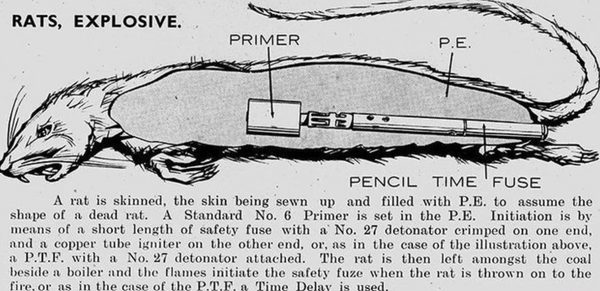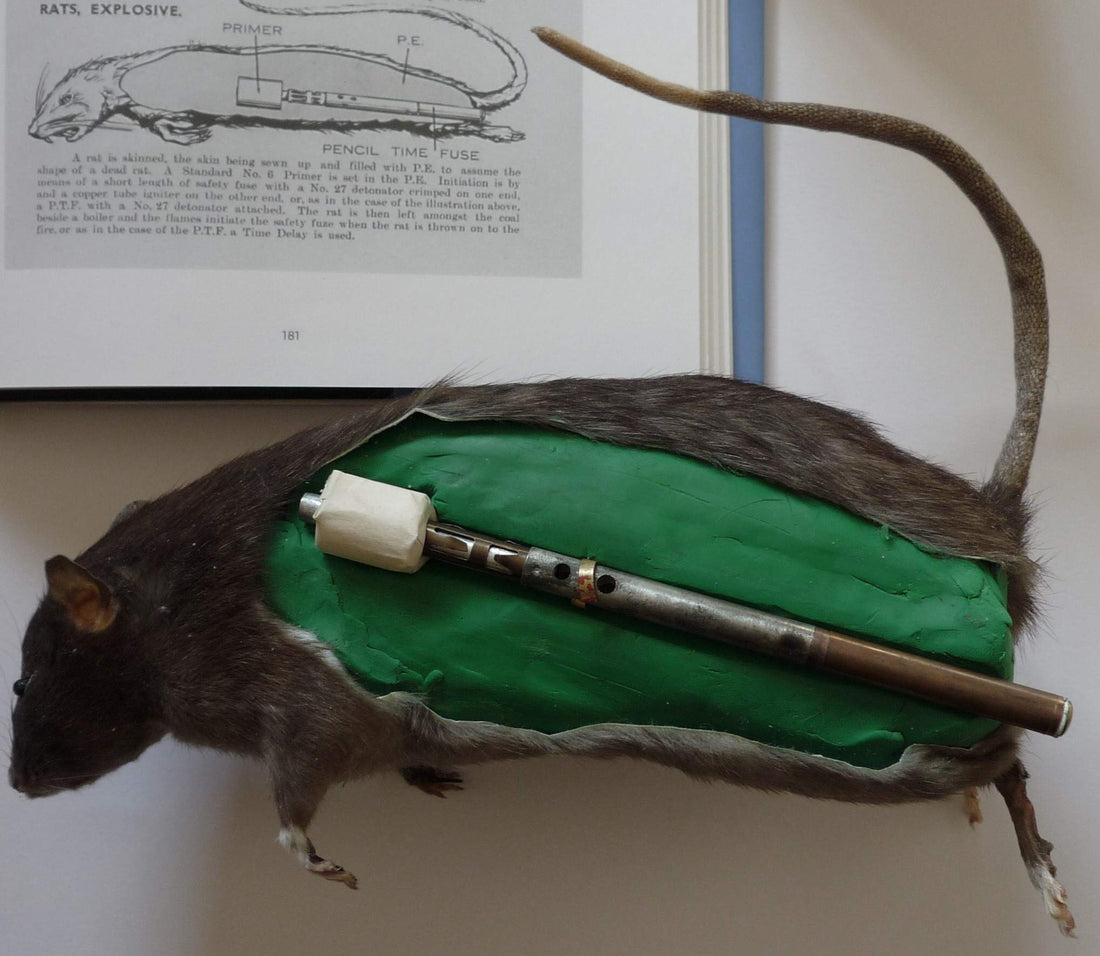In intelligence operations, time matters. While our Dispatch articles traditionally focus on watches, today we look at another tool to measure time, the time pencil. It’s a short time fuze detonator used for explosive charges in covert operations in World War II. We have profiled watches of the Glorious Amateurs of the Office of Strategic Service (OSS) officers in World War II, this is another time measuring tool they used to accomplish their mission.

By JR Seeger
The allied support to resistance operations in Occupied Europe focused on sabotage operations before D-Day and then more aggressive combat operations after the fact. The challenge for sabotage operations was to conduct said operation but live to fight another day. Some of the most effective sabotage operations took place inside factories where enslaved workers would periodically insure whatever came off the assembly line was not quite to specifications. Still, the most dramatic of the resistance operations before D-Day focused on using explosives against roads, bridges, and railways.
In 1939, with the Nazi blitzkrieg closing in on Warsaw, Polish military intelligence officers provided the small British contingent with intelligence and technology to be taken to England. Officers from the Secret Intelligence Service and the military intelligence contingent, including Lieutenant Colonel Colin Gubbins, returned to England with a treasure trove of intelligence including prototypes of a chemical time delay fuze. The prototypes were shared between SIS Section D (D for destruction) and Gubbins unit military intelligence unit focused on resistance operations. In 1940, these two offices were combined to become a new, independent organization, the Special Operations Executive (SOE).

British Irregular Warfare: When the British SOE started their resistance training in England in 1940, explosives training was one of the primary classes. The SOE training on demolitions in the first years of the war was based entirely on military demolitions techniques including the use of standard military blasting caps and fuzes lighted either by a match or a simple friction plunger system known as a fuze ignitor. Based on this training, a resistance team had to emplace explosives and remain quite close to the actual blast – certainly no more than a few minutes away depending on the length of fuze used. While this technique worked well for combat engineers supported by infantry, it was not designed for a resistance group that wished to conduct sabotage and avoid capture.
British scientists were already working on multiple time delay mechanisms, but their work focused on supporting other British irregular forces like the Commandos and other Small Scale Raiding Forces associated with the SOE. The Polish design was modified to create “time pencils” that used a chemical process as a time delay. Time pencils were used in the commando raid on the dry docks in St. Nazaire in March 1942. However, the reality was that British scientists simply did not have the resources to create a standardized time delay device that could be used by resistance forces across Europe.

British Commandos, 1942 (Wikipedia Commons)
Enter the Americans: After Pearl Harbor, William Donovan expanded the capabilities of his new office, the Coordinator of Information (COI), to include irregular warfare. Donovan provided the President with an irregular warfare plan in the summer/fall of 1941, but the US was still neutral, and President Roosevelt was not about to approve Donovan’s plans for special operations. By mid-December 1941, Roosevelt approved Donovan’s plans and he began to recruit America's counterpart to the SOE. Sabotage and subversion were central to Donovan’s strategic plan.

In the early months of 1942, the COI and its successor in June 1942, Office of Strategic Services (OSS), were criticized at the time by generals at the Pentagon as simply a gathering of Ivy League intellectuals with little or no understanding of modern warfare. Donovan did gather some of the great minds of the American universities and industry and focused their skills on what he saw as a key part of modern war – irregular or partisan warfare.

One of the key individuals in this new type of warfare was Stanley Lovell. Lovell was a successful industrial chemist and professor at Harvard when Donovan recruited him to use American technology in support of irregular warfare. Lovell was the chief of the OSS unit known as Research and Development and R&D designed and produced dozens of special weapons and equipment for the OSS and the SOE. One of the most useful and probably the smallest of Lovell’s devices was a modification of the British version of the “time pencil.”

Lovell’s time pencil was an ingenious blend of chemistry and technology that could be mass produced and shared with resistance groups throughout Europe. It was a combination of a standard fuze ignitor at one end and a corrosive chemical compound at the other. When the corrosive compound was crushed inside the tube, it slowly eroded a fuze ignitor. The amount of the chemical mix allowed for time pencils to be created that delayed ignition from a few minutes to up to 24 hours. That meant that the saboteur could emplace the demolitions, lay out the camouflaged fuze, mix the chemicals by crushing one end of the time pencil and then leave. At a precise time, the time pencil would ignite the fuze, and start the explosive chain that would end with an explosion of plastic explosives. With the delivery of the time pencils, saboteurs and their resistance security partners could be miles away from the site when the explosion occurred and the inevitable Nazi investigation would begin. They could even conduct multiple operations in the same night.

Of course, time pencils were not foolproof, and the chemical reaction would be affected by ambient temperature and other environmental factors. Still, the use of this new sabotage technique, coupled with an accurate wristwatch for keeping track of the time before the explosion made the resistance more effective. The time pencil was another example of cooperation between the US and UK teams supporting special operations. Like the easily ignored watch or the suitcase radio that made air and coastal delivery of resistance men and equipment possible, the time pencil was a small device with a big impact on special operations in World War II.

Magnetic charge with Time Pencil placed on a vehicle (Imperial War Museum)
READ NEXT: The Pragmatic Journey of a SEAL Through Watch Collecting

--
J.R. Seeger served as a paratrooper in the 82nd Airborne and as a CIA officer for a total of 27 years of federal service. He served 17 years in multiple field assignments focused on counterterrorism, counterintelligence and irregular warfare. During his final, 3-year assignment in CIA Headquarters, he first served as a chief of operations for a geographic division in the Directorate of Operations and then served as a deputy director and deputy chief of the CIA Counterterrorism Center. Seeger led multiple, small unit teams during his service, including leading one of the CIA teams that infiltrated into Afghanistan after 9/11.
Since his retirement, J.R. has written articles and book reviews in the CIA professional journal “Studies in Intelligence” and the T.E. Lawrence Society newsletter. His eight-part MIKE4 series is about a family who have served in the special operations and intelligence community from World War II to the present.








6 comments
I am developing a book involving an early Section D major working with Dutch resistance soon after the German invasion, in May 1940. I assume that the pencil detonator was not yet functional enough to have been supplied even to a primary resource such as this soldier. Am I correct? Can you state more specifically when the device may have been field operational to some degree? Thanks for such insights already!
If this account is true, then the Wikipedia page should be modified. I suspect that you are referring merely to an American modification and production of a British product. You also fail to mention the creep fuze.
If true, the Polish contribution should certainly be included on the wikipedia page.
Excellent article and I had not known the extent of OSS involvement in the time pencil… always thought it was the British Boffins! Beautifully written and informative. Cheers! RPR PS. Your title is a nice tribute to fellow CIA Officer (and also 82nd Airborne alum) James Stejskal’s first novel: “A Question of Time.” Fantastic ‘fiction’ book based on his time in Det. A, Berlin Special Forces. It is a very worthy read!!! If the powers that be will pass on my e-mail or a mail drop, I will gladly send Mr. Seeger a signed copy of Jim’s book for Christmas!!! I have a few spares!
Fantastic…the development of such ingenious devices is often as intriguing as the device themselves. Thanks for such a great dispatch!
Very well written! It’s neat to learn about genius inventions that had such a huge impact on history that most people never hear about. Keep the articles coming guys!